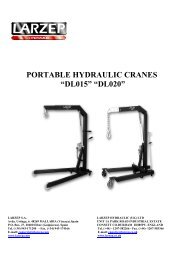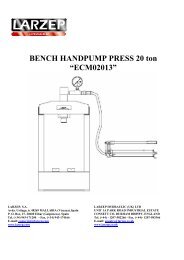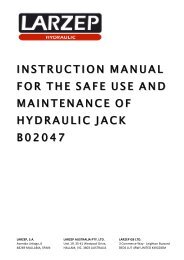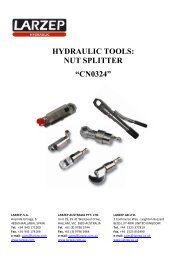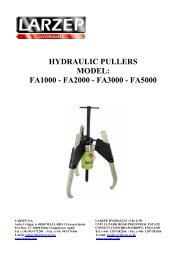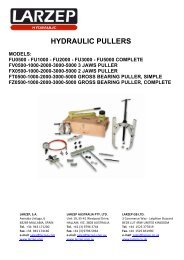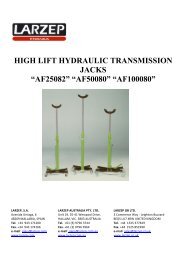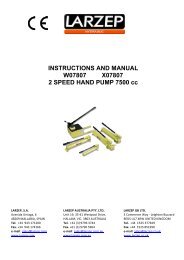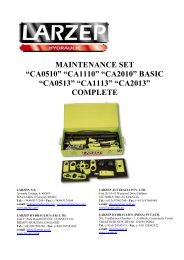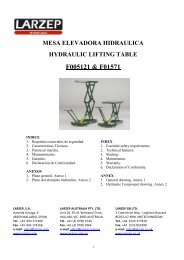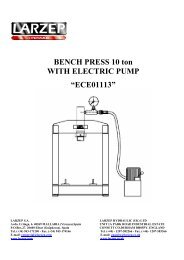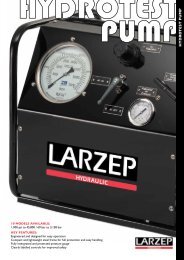manual de instrucciones y mantenimiento instruction & maintenance ...
manual de instrucciones y mantenimiento instruction & maintenance ...
manual de instrucciones y mantenimiento instruction & maintenance ...
Create successful ePaper yourself
Turn your PDF publications into a flip-book with our unique Google optimized e-Paper software.
CYLINDER-HAND PUMP INSTRUCTIONSUnpack and visually check all the components, making sure that there are no oil leaks, loose or damaged plugs, damaged threads, etc. Never use componentsthat are damaged or appear to be in poor condition.Assemble the <strong>de</strong>vice in accordance with the <strong>instruction</strong>s given in the diagram, first checking that you have all the necessary material.Check the correct installation and perfect functioning of the <strong>de</strong>vice with a load, in accordance with the procedure outlined below:SINGLE ACTION INSTALLATION1. Release the pump drive lever by removing the hook from the lever-hol<strong>de</strong>r housing.2. Pump <strong>manual</strong>ly with the drive screw open (rotate a few times to loosen) in or<strong>de</strong>r to fill the pump’s internal circuit with oil.3. Close the drive screw by turning clockwise <strong>manual</strong>ly. You do not need to close too tightly.4. Now pump using the drive lever. First, fill the hose with oil. The number of thrusts required will <strong>de</strong>pend on the length of the hose and the flowsupplied by the pump piston. With single-speed pumps, the flow will remain the same at all times, regardless of the load or pressure. With twospeedpumps, the large piston will be activated during the load-free feed movement, and when the <strong>de</strong>vice comes into contact with the load, aninternal large piston relief value will be automatically triggered and only the oil supplied by the small piston will be available up to 700 kg/cm”,which is the maximum pressure for the <strong>de</strong>vice.5. Once the hose is full of oil, the cylin<strong>de</strong>r piston will start to advance.6. If the cylin<strong>de</strong>r has a mechanical limit switch capable of withstanding the maximum <strong>de</strong>vice pressure, continue pumping until the limit switch isreached.7. If any control elements (pressure gauges) are available, you will be able to see how the pressure increases along with the effort required to movethe lever.8. Keep pumping until you obtain the maximum pressure (700 kg/cm”). In this way you will be able to check the correct functioning of the internalsafety valve and the absence of oil leaks in the installation.9. Maintain pressure in the installation for a short period of time (1 minute) without pumping, in or<strong>de</strong>r to check the correct functioning of thepump’s check valve.10. Gently open the pump’s drive screw (by turning anticlockwise) in or<strong>de</strong>r to protect the fall of the pressure gauge needle. Do not force the drivescrew open. The cylin<strong>de</strong>r will not move back more quickly because the screw is looser. A couple of turns will be sufficient.11. If the cylin<strong>de</strong>r has a return spring (SM, SMP, SMX, SH, TE, T, SAM, SAH, CY, KC) the piston will move back automatically. The return speedmay be slow in some applications. In this case, we recommend the use of double effect cylin<strong>de</strong>rs. In the case of load return cylin<strong>de</strong>rs (SP, SX,SL, SSR, STR, STX), you will need to push the piston back using more or less force, <strong>de</strong>pending on the size and position of the cylin<strong>de</strong>r.12. In cylin<strong>de</strong>rs without a mechanical limit switch (SSR, STR, STX) this type of test cannot be carried out. If you do not have a test bench, you willhave to test the installation using the actual load in the application. This operation should be carried out with extreme care by experiencedpersonnel and maximum safety measures should be applied.13. Repeat the processes as many times as necessary until you are comfortable handling the <strong>de</strong>vice.14. If using close or check valves, or working with various cylin<strong>de</strong>rs via flow distributors, remember to take into consi<strong>de</strong>ration the effect theseaccessories may have on the functioning of the <strong>de</strong>vice, and establish an operating procedure in or<strong>de</strong>r to avoid unwanted effects.DOUBLE ACTION INSTALLATION1. The connection of the quick plugs is, if possible, even more important here, since a bad connection will not only prevent the <strong>de</strong>vice fromfunctioning, it may also generate excessive pressure build-up that may cause the cylin<strong>de</strong>r to break. Take note of which hose connects to the thrustchamber and which to the return chamber.2. All double action Larzep cylin<strong>de</strong>rs are equipped with a mechanical limit switch capable of withstanding the nominal pressure. You can thereforecarry out the test <strong>de</strong>scribed in the previous section. If you are working with another type of cylin<strong>de</strong>r and are not 100% sure, do not carry out thistest.3. Release the pump drive lever by removing the hook from the lever-hol<strong>de</strong>r housing.4. Turn the control of the distributing valve to the central position and pump and few times to fill the internal channels with oil.5. Turn the lever to one si<strong>de</strong> and pump. Oil will flow through the hose connected to the si<strong>de</strong> to which the valve lever is rotated. If this hose isconnected to the cylin<strong>de</strong>r’s thrust chamber, the piston will move forward. The oil in the return chamber will flow freely through the other hose tothe pump tank. Until the moment the cylin<strong>de</strong>r connects with the load, flow is supplied by both the large and small pistons.6. Continue pumping until you reach the limit switch. At this moment an internal large piston relief value will be triggered, and only the oil suppliedby the small piston will be available. Subject the installation to pressure to check for leaks.7. Stop pumping and check (preferably using a pressure gauge) that the installation maintains the pressure level.8. Turn the valve lever to the other si<strong>de</strong> and pump. Oil will flow to the return chamber and the piston will move back. The oil in the thrust chamberwill flow freely back to the tank.9. Repeat the processes as many times as necessary until you are comfortable handling the <strong>de</strong>vice.10. If using close or check valves, or working with various cylin<strong>de</strong>rs via flow distributors, remember to take into consi<strong>de</strong>ration the effect theseaccessories may have on the functioning of the <strong>de</strong>vice, and establish an operating procedure in or<strong>de</strong>r to avoid unwanted effects.6



